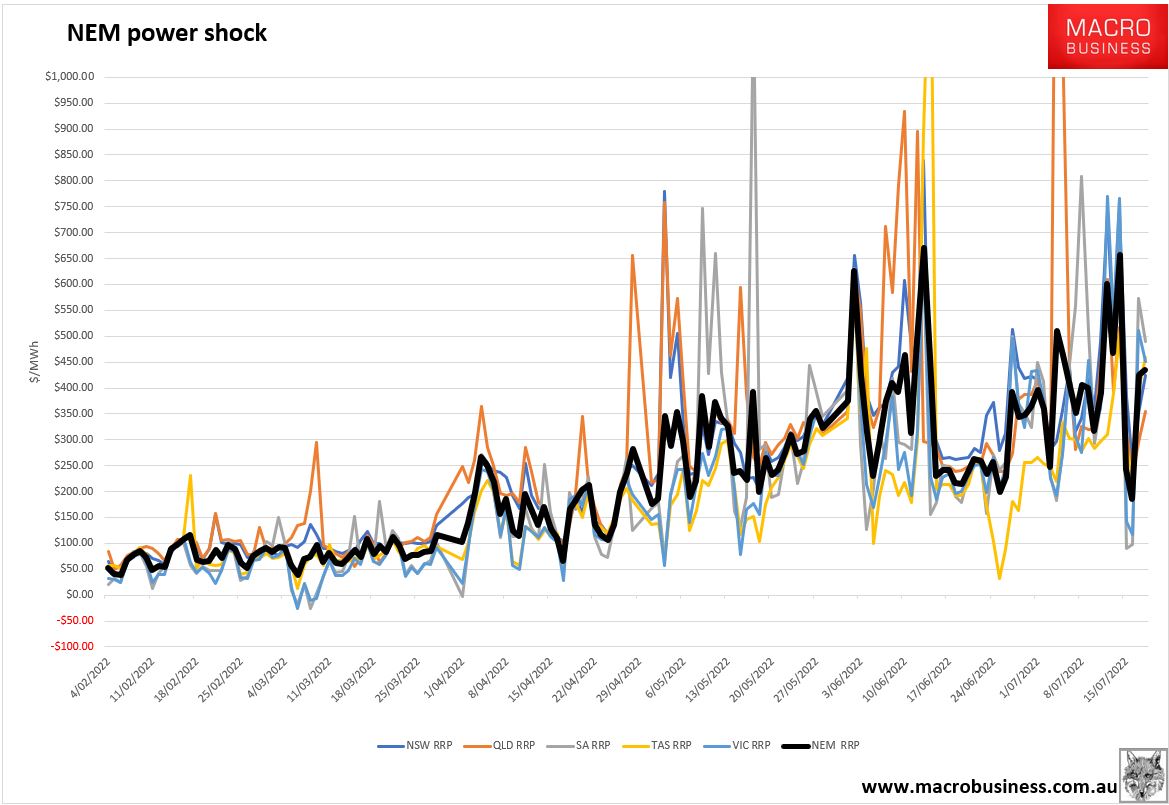In yesterday’s RBA minutes, the Albanese Government’s insane energy shock got a good airing:
Ahead of the release of the June quarter Consumer Price Index (CPI) at the end of July, members noted that domestic inflationary pressures, including those outside of the labour market, continued to build. Non-labour input cost pressures were evident across a range of industries. Adverse weather conditions had affected the prices of some fresh produce. Rents were expected to pick up in response to tightening rental market conditions across most of the country. Wholesale electricity and gas prices had also increased sharply in recent months, reflecting domestic supply disruptions during a period of increased demand. The effect of these increases on retail electricity and gas prices was expected to be evident later in the year, since state subsidies and hedging arrangements had limited the near-term pass-through. More generally, firms in the Bank’s liaison program had indicated a greater propensity to pass through cost increases to consumer prices. As a result of these price pressures, inflation was expected to increase in year-ended terms through the remainder of 2022.
In short, the MB forecast for an additional 5% added to the CPI over the next year is looking spot on. After all, that’s what’s happening globally, given energy and food are the same trade:
Now let’s add some Bill Evans to the mix:
When central banks make a big decision, the commentary will usually err on the side of justifying the decision.
But there is more than that in these Minutes. The standard practice of 25 basis point increments appears to have been discarded for the time being.
The assessment of the economy is quite upbeat highlighting the obvious strength of the labour market; risks around the outlook for wages growth; and the current resilience of spending. The collapse in consumer confidence is noted but qualified against the current spending. The weakness in the housing market is compared with how far prices have already increased.
Further rate hikes are clearly being signalled while the “neutral rate” is seen to be well above current rates.
The inflation outlook is deteriorating further – electricity; gas prices; rents; materials; and the liaison pointing to business’ greater pricing power.
While the Minutes do refer to the upcoming Inflation Report a downside surprise is unlikely to have any real influence on the decision in August.
Nevertheless, we do expect that the Board will resist the option to raise the cash rate by 75 basis points in August with 50 basis points remaining the preferred option.
After all, there are still four more meetings this year.
Finally, the energy shock just keeps getting worse:
The Australian Energy Market Operator has requested Queensland’s LNG exporters to again make more gas available for the southern states as it warned of a shortfall of natural gas lasting out until the end of September that could destabilise the Victorian supply system.
The shortfall, which affects Victoria, NSW, South Australia and Tasmania, represents an escalation of the energy crisis gripping the eastern states.
,,,But further action was deemed necessary, and in a meeting of market participants on Tuesday, AEMO is understood to have asked the three Queensland LNG exporters – Santos’ GLNG venture, Shell’s QCLNG and Origin Energy’s Australia Pacific LNG – whether they had capacity to make more gas available to send south.
As the associated power shock goes on:

How did Treasurer “Dim Jim” Chalmers respond to these alarming developments? When Joseph Stiglitz suggested super profits taxes yesterday, Dim Jim again hosed off any policy undertaking to address the core energy inflation problem.
Indeed, all of Albo’s cowards appear to have their heads firmly up their arses. Judith Sloan:
Speaking at an energy conference in Sydney last week, the Prime Minister was still predicting cheap energy and a resurgence of manufacturing. Evidently, we can be an energy superpower because we have a lot of sun and wind. Throw in green hydrogen (which is unproven at scale and at an affordable price) and the energy outlook is extremely rosy, according to him.
Bowen even had the nerve to pat himself on the back for keeping the lights on recently, while claiming the answer lies in increased investment in renewables and additional transmission lines. He seems to be ignoring the implications of the total closure of the Liddell coal-fired plant next year and the large Eraring plant in 2025, coupled with the delay in the commissioning of Snowy 2.0. Most engineers are predicting ongoing stresses on the east coast grid for many years as more coal-fired plants exit.
The new “Dim Jim” Chalmers is fast shaping as the old “Dim Jim” Scullin.
In 1929, two days before the Wall Street crash, ALP PM and Treasurer, James Scullin, brought a suite of terrific policies to power. They never saw the light of day because his government disintegrated in the ensuing economic wipeout.
Likewise, unless “Dim Jim” Chalmers wakes up and fixes the energy crisis with super profits taxes, export levies, or domestic reservation, he is going to crash house prices and the economy in record time and the Labor agenda will be wiped out in a national panic for which it will never be forgiven.


